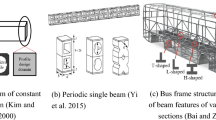Abstract
This paper describes an algorithm for structural topology optimization entitled Constrained Adaptive Topology Optimization or CATO which is applied here to produce the optimum design of shell structures under free vibration conditions. The algorithm, based on an artificial material model and an updating scheme, combines ideas from the more mathematically rigorous homogenization (h) methods and the more intuitive evolutionary (e) methods. Thus, CATO can be seen as a hybrid h/e method. The optimization problem is defined as maximizing or minimizing a chosen frequency with a constraint on the structural volume/mass by redistributing the material through the structure. The efficiency of the proposed algorithm is illustrated through several numerical examples.
Similar content being viewed by others
Author information
Authors and Affiliations
Additional information
Received February 17, 2000
Rights and permissions
About this article
Cite this article
Belblidia, F., Bulman, S. Constrained adaptive topology optimization for vibrating shell structures. Struct Multidisc Optim 22, 167–176 (2001). https://doi.org/10.1007/s001580100134
Published:
Issue Date:
DOI: https://doi.org/10.1007/s001580100134




